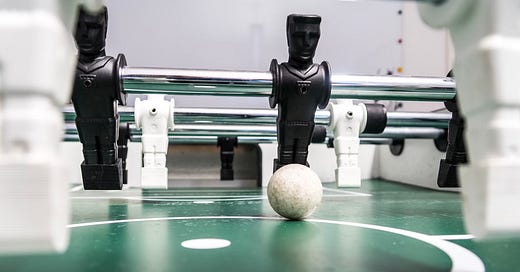As a Product Manager (PM), you have probably done countless kickoff meetings. This article will focus on the meeting itself. You can generalize these key takeaways for other kick-off meetings. A friend and fellow PM used to mention that no development work would begin in his organization, until the project is initiated with a proper kickoff meeting. Starting an initiative on the right foot sets the tone for the team on how the project will run. This can be used anywhere to kick-start a project.
Photo by Florian Schmetz on Unsplash
Purpose of the kick-off meeting
Kickoff meetings are meant to communicate and align your stakeholders on what problem you are solving, why it is an important problem and your plan to solve it.
Attendees at your kick-off meeting
Invite everyone who is a sponsor or contributor to your initiative. Using a RACI model can help you define these people.
A typical attendee list would include:
Executive sponsor - VP or Head of Product or Engineering
Engineering teams
Product designers and UX researchers
Program manager - to help manage the initiative
Cross-functional teams - Product Marketing , Legal, Documentation, Advocacy and Sales Enablement
If not everyone is in the same timezone there are a few ways you can work around it including recording the meeting or leveraging asynchronous tools.
Ideal preparation head of the kick-off meeting itself
Your main goal before the meeting is to ensure your key stakeholders are already aligned before the meeting. In order to have a good meeting, a lot of context should be shared beforehand so that everyone is on a good starting point at the kick-off itself.
In order to do so, have 1:1s with your executive sponsor, engineering, design leads and product marketing manager. Use those meetings to solicit feedback on your solution and plan. Ensure that you capture their concerns and risks. Have a risk mitigation plan ready to be able to discuss with them. Allow for time ahead of the kick-off, if it is already scheduled to book in these 1:1s, especially if there are last-minute cancellations.
No information shared in the kickoff meeting should come as a surprise to your key stakeholders.
What needs to be covered during the kickoff meeting
A general agenda for your kick-off meeting should include -
Introduction
What problem are we solving
Why are we solving it and what urgency
Roadmap and plan for execution
Teams involved in the execution
Process for communication
Risks and Concerns
This should be shared beforehand so attendees can come prepared with the right mindset.
Keeping your audience engaged during the kickoff meeting
Introduction
If you are a Product Manager at Amazon, your kickoff will probably begin with a one-pager. At other companies - especially ones with remote workers or global teams, your kickoffs could likely be a Zoom meeting packed with content and people.
What problem are we solving
After the introductions are complete, the next step is for the PM to share the problem they are solving and why it is important to solve it now. Sharing videos or quotes from your customers increases empathy and adds credibility to the problem. Discuss the scale of the problem using data and graphs.
Why are we solving it and urgency
Visualizing the solution becomes easier with early prototypes of the solution. The experience is more engaging if we can weave a story of how the solution solves the customers’/consumers’ problem. In most cases, I use a variation of the Storyboarding technique.
Teams involved in the execution
Keeping your audience engaged during that hour is easier if there are multiple speakers. Invite the program manager, engineering lead, and product designer to present during your kick-off meeting.
Concluding the meeting - including the process for communication
Transparency and accountability are important. Share how the teams should communicate and collaborate with each other. It could include Slack, documents, emails and/or meetings. My preference is a combination of all of these. Using documentation and Slack for collaboration, meetings to drive decisions and resolve conflicts and email for periodic updates to stakeholders.
If your organization does not have a formal kickoff process, this can be any other meeting to share more about the problem space and the plan to address it. By mastering the art of the kickoff meeting, you'll set your project on a trajectory for success, establishing clarity, alignment, and enthusiasm among your stakeholders.
Thank you for reading the article! You can help us:
✉️ Subscribe using this button
⏩ Share this directly with your peers and others who will find this helpful. Apply what you have learned and teach it to someone else, it will make it easier to recall later.
💬 Share this article on your Social Media (Twitter (we’re @readaskwhy), LinkedIn)
📥 Email us your questions, comments, and ideas. Simply reply to this email to contact us.




